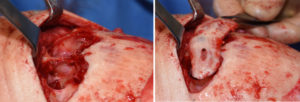Brow bone reduction is done for a variety of reasons in both men and women. While the primary objective is to reduce an overlying prominent brow protrusion, there are differences in why it is done and the technique used to achieve it. In men reduction of the brow bone is done to get rid of the Neanderthal’ look. In women a softening effect is needed to make the forehead more vertical from the brow upward. In the male to female transgender patient, the brow bone must be brought back and reshaped from the frontonasal junction out to the tail of the brow for a complete change in the periorbital appearance.
Brow brow reduction can be done by either a burring technique or actually cutting off the outer cortical bone and reshaping and moving it backwards. (osteoplastic bone flap setback) The differences between these two brow reshaping methods is more than just technique alone but in the amount of brow bone reduction achieved. Because a prominent brow is the reflection of how big the underlying front sinus is, burring can only reduce it by a subtotal thickness of the thin anterior table bone. This is usually less than 5mms and can often be only a few millimeters. Cutting out the bone and moving it back into the frontal sinus air space creates a far greater amount of brow protrusion reduction.



The bone flap is placed back into position which should be further back into the frontal sinus cavity. It can be appreciated that the amount of brow bone reduction is a combination of the bone flap reset into the frontal sinus and the thinning of the bone flap by burring. The former is more important for the actual setback, the latter is more to make for a flatter outer brow bone shape. A single central low-profile bone plate is all that is needed for fixation. This should be for assured immobility and not to hold it out in space over the frontal sinus. The fit of the bone flap should primarily be against the midline bony septum with resting on much of surrounding bone edges. There will always be some open areas along the seams which can be covered by Surgical mesh or bone wax.
With an understanding of how the osteoblastic bone flap technique of brow bone reduction works, it is easy to see how it is far more effective than a burring reduction method. But if a complete brow bone reduction technique is needed, such as in facial feminization surgery, burring reduction is also needed to reshape the tail of the brow bone.
Dr. Barry Eppley
Indianapolis, Indiana




